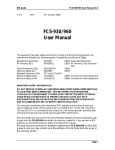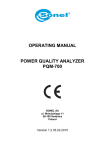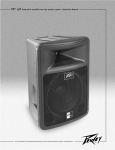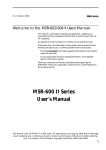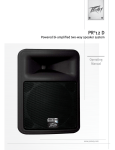Download BSS Audio FCS-960 User`s manual
Transcript
V2.2 8 December 1995 Welcome Welcome to the FCS-930/960 Users Manual FCS-930 DUAL MODE GRAPHIC EQUALISER FCS-960 DUAL MODE TWO CHANNEL GRAPHIC EQUALISER The aim of this manual is to assist sound engineers, installers and consultants to fully understand the FCS-930/960; and to benefit from its maximum capability. As opposed to most manuals, the contents can be read like a book. At the same time, the information is structured under a series of broad headings for easy access. So where possible within each section: . The most immediate information appears at the head of each section under the main title. . As you read further into each subsequent section, more detailed,specific information is given. Should you have any comments or questions about applying the FCS930/960 series within your application, please write to us at the address in the warranty section. FCS-930 FCS-960 User's Manual This Manual is the COPYRIGHT of BSS Audio. All reproduction and copying, other than for the legal owner's personal use, or disclosure of part or whole to a third party, without prior written authorisation, is in violation of the European Copyright Convention. BSS Audio 1995 1 FCS-930/960 This equipment has been tested and found to comply with the following European Standards for Electromagnetic Compatibility. Emission Specification EN55013 1990 (Associated equipment) Immunity Specification EN50082/1 1992 (RF Immunity, Fast Transients and ESD) Mains Disturbance EN61000/3/2 1995 For continued compliance ensure that all input and output cables are wired with cable screen connected to pin 1 of the XLR. The input XLR pin 1 on BSS equipment is generally connected to chassis via a capacitor to prevent ground loops whilst ensuring good emc compatibility. 2 Table Of Contents Table Of Contents 1.0 Introduction 4 2.0 Unpacking 5 3.0 Mechanical Installation 6 4.0 Connections 7 4.1 4.2 4.3 4.4 4.5 4.6 5.0 AC Voltage Setting Safety Earthing AC Power Fusing Audio Connections Ground Loop Control Powering Up Control Descriptions 5.1 5.2 Front Panel Rear Panel 8 8 8 9 10 10 11 11 12 6.0 Using the FCS-930/960 13 7.0 Filter Shapes and Interaction Effects 15 8.0 Appendix 18 8.1 8.2 8.3 8.4 9.0 10.0 Chassis/0v Link Removal Transient Suppressor Replacement Optional Transformer Fitting Optional Security Cover 18 18 19 19 Technical Specifications 20 Warranty 22 User Notes Front Panel Recall Sheet 23 26 3 FCS-930/960 Introduction 1.0 Introduction The FCS-930 and FCS-960 are dual mode graphic equalisers; each channel featuring 30 filter bands spaced at the standard one third octave ISO frequency centres spanning 25Hz at the low frequency end up to 20kHz at the high frequency end. The FCS-930 is a single channel unit, while the FCS-960 has two independent channels that may be used as a stereo pair. The filter topology used is not based on the more common gyrator principle, butrather on a band pass multiple feedback technique which makes less demands on the integrated circuits at high frequencies. The resulting excellent sounding circuit also offers good long term stability and a constant Q response. This is also configurable to allow you to select the optimum response shape, dependent on whether you wish to provide gentle program sweetening, or precise single frequency tuning, such as notching room resonances and feedback suppression. Some of the features available within the FCS-930/960 are: • Long 45mm fader travel for precise adjustment and control. • Centre detented fader with electrical centre tap for true 0dB setting. • Advanced constant Q filter topology for improved accuracy at all fader settings and excellent sonic transparency. Selectable normal or fine filter response. • Continuously variable high pass filter, with by-pass switch. • Gain control for system loudness normalisation. • Peak clip LED to give advance warning of signal overload. • Channel bypass selection and power fail bypass by relays. • Electronically balanced inputs and outputs. • Proprietary design fader knob provides positive feel with ample finger room, virtually eliminates visual parallax errors even under low ambient light conditions • Optional internal input and output transformer balancing. 4 Unpacking 2.0 Unpacking As part of BSS AUDIO's system of quality control, this product is carefully checked before packing, to ensure flawless appearance. After unpacking the unit, please inspect for any physical damage and retain the shipping carton and all relevant packing materials for use should the unit need returning. With the FCS-930/960 will be a small packet of spare fuses. Please keep them in a safe place. If any damage has occurred, please notify your dealer immediately, so that a written claim for damages can be initiated. See the Warranty section of this manual. 5 FCS-930/960 Mechanical Installation 3.0 Mechanical Installation A vertical rack space of 2U (3.5", 88.9mm) for the FCS-930, and 3U (5.25", 133.4mm) for the FCS-960 is required. You must support the unit at it’s rear by additional bracing or shelving if it is to be used in a transportable system. Failure to do so will impair reliability and invalidate the Warranty. Figure 1 details the relevant dimensions and fixing centres. Adequate ventilation must be provided for by allowing sufficient room around the sides and rear of the unit to ensure free circulation of air. Forced cooling is not required. The front of the unit should not be exposed to long term direct sunlight as this can have a detrimental long term effect on the control knobs. The internal power supply transformer is mounted on the case rear. After a period of time in an enclosure, the metal case will feel hot to the touch, but this is quite normal and should not be a cause for alarm. Fig. 1 Mechanical Dimensions 6 Unpacking Warranty Warning 4.0 Connections Before connecting your unit to its AC power source, check that the voltage selector switch located on the rear panel is correctly set. See figure 2. WARNING: THIS APPLIANCE MUST BE EARTHED. IMPORTANT: The wires in this mains lead are colour coded in accordance with the following code: Green and yellow : Earth Blue : Neutral Brown : Live As the colours of the wires in the mains lead of this appliance may not correspond with the coloured markings identifying the terminals in your plug, proceed as follows: The wire which is coloured green and yellow must be connected to the terminal in the plug which is marked with the letter 'E' or by the earth symbol , or coloured green and yellow. The wire which is coloured blue must be connected to the terminal which is marked with the letter 'N' or coloured black. The wire which is coloured brown must be connected to the terminal which is marked with the letter 'L' or coloured red. Those units that are supplied to the North American market will have an integral moulded 3 pin connector which is provided to satisfy the area safety standards. Fig. 2 Mains Voltage Switch and Fuse 7 FCS-930/960 AC Voltage Setting Safety Earthing AC Power Fusing 4.1 Voltage Setting The mains voltage selector switch provides simple, external adjustment for operation on all international AC power standards. At each switch position there is an acceptable tolerance over which the performance of the unit will not be affected and this is 90v-132v for the 120v position, and 190v-264v for the 240v position. If you subject the unit to voltages in excess of this you are likely to cause damage. If the mains voltage is below those specified, there will be reduced performance before the unit finally fails to work. 4.2 Safety Earthing The green/yellow wire of mains cord must always be connected to the electrical installations Safety Earth or Ground. It is essential for personal safety, as well as proper operation of the unit, and is internally connected to all exposed metal surfaces. Any rack framework that this unit might be mounted into is assumed to be connected to the same grounding circuit. The FCS-930/960 has electronically balanced audio connections and does not need disconnection of any safety earth for the avoidance of hum loops. 4.3 AC Power Fusing The incoming mains power is fused within the FCS-930/960 by the fuse holder mounted on the rear panel. If it needs to be replaced it must be properly rated as: 20mm T200mA for 240v mains operation, and T250mA for 120v mains operation. It is most important for continued safety that this specification is adhered to, and you will have found that a spare fuse of this rating is supplied together with your unit and manual. It is very unlikely that this fuse will fail during normal use, and must be treated with some caution as to the cause, if it should do so. One of the most likely reasons will be following the incorrect setting of mains voltage switch on the rear panel. Another reason can be the inadvertent connection of line to line rather than line to neutral phase voltages when using a three phase power connection. In either case internal transient suppressors can become damaged and will consistently blow replacement fuses. You can be assured that they have protected your unit from damage, but they will need removal to allow further use of your unit, and should be replaced as soon as possible to ensure continued protection. If you feel this has happened please refer to the appropriate section at the rear of this manual for the removal and replacement procedure. 8 Audio Connections 4.4 Audio Connections The FCS-930/960 audio inputs are RFI filtered and electronically balanced, with the outputs electronically balanced and floating. They are designed to operate at any signal level up to +20dBu and will drive into loads of 600 ohms or greater. They will be ‘fuss free’, regardless of your installation’s complexity. Figure 3 shows the connector wiring. Note that pin 1 of the input XLR is not connected to ground. Balanced Wiring Whether your system is wired to a ‘pin 3 hot’ or a ‘pin 2 hot’ convention will not matter as long as your wiring to both the input and output 3 pin XLR connectors are the same . As is common with all other BSS equipment of this type, we follow the convention of ‘screen goes forward with the signal’. Input cable screening therefore needs to be derived from the signal source end as pin 1 is ground lifted for the inputs. You should use high quality audio cable with 2 cores + screen for low noise and reliability, and to side-step potential problems. Unbalanced Wiring If the equipment driving the FCS-930/960 has only unbalanced outputs then you will need to add a wire jumper such that the screen connection on Pin 1 of the XLR is shorted to either Pin 2 OR Pin 3, depending on the wiring convention of the unbalanced equipment. If the equipment being connected to the FCS-930/960 outputs has only unbalanced inputs, then we recommend that you still use a balanced (i.e. 2 core shielded) cable. The interconnecting cable should have it’s screen grounded by pin 1 of the FCS-930/960 output, the pin 3 output should be connected to the unbalanced input 0v ground, and the pin 2 output should be connected to the live input. There should be no connection between the cable screen and 0v/chassis ground connection of the unbalanced equipment. Strict adherence to this will help to eliminate potential ground loop hums by removing signal currents from the cable screen. Fig. 3 Input and Output Connector Wiring 9 FCS-930/960 Ground Loop Control Powering Up 4.5 Ground Loop Control Strict adherence to the wiring conventions noted above within a fully balanced signal system will yield the best possible results with none of the problems normally associated with interconnected audio equipment. Wherever possible, cable screens should not be connected to any signal pin, but rather left to perform a cable shielding function only. Where it is not possible to control all of the external cabling, it might become necessary to have the internal electronic ground of your unit separated from the case safety ground. Provision is made internally within the FCS-930/960 to separate these two grounds at a convenient point, or to add a suitable impedance network as part of a house system requirement. Please refer to a later section for information on this procedure.6. Under no circumstances should the safety ground wire be removed from the mains AC power connector as an interim measure to achieve similar results. 4.6 Powering Up 10 When the FCS-930/960 is switched on by operating the power on-off switch located on the rear panel, the front panel LED showing the normal MODE will be illuminated. This indicates to you that the internal power supply circuitry is functioning correctly. The unit will also be in it’s bypass mode. Should you subsequently have the EQ IN switch selected before power up, there will be a slight delay before the bypass relays operate to allow time for the internal circuitry to settle down. This ensures a silent power up without danger of causing damage to other equipment connected to the unit’s outputs. Control Descriptions Front Panel 5.0 Control Descriptions 5.1 Front Panel 1 Filter boost and cut fader control. Move this fader to vary the amount of boost or cut required, at the frequency of the fader. It has a centre detent and electrical centre tap which guarantees you a precise ‘flat’ setting in the central position. 1 2 Gain adjustment control with +/- 10dB of range. Adjust this if you wish to balance the equalised sound with the general loudness of the unequalised sound. The control has no effect on the bypassed signal level. 3 EQ IN selector. Push to select equalisation, release to bypass. The LED indicator illuminates to confirm the equalisation in status. Bypass is achieved by using relays which ensures a complete equipment bypass. 4 Peak LED indicator gives you advance warning of possible circuit overload by illuminating 2dB before actual clip. It is monitoring signals both before and after the GAIN control [2] and will operate should any one of them exceed the danger level. Should this occur, then the signal level entering the FCS-930/960 will need to be reduced in level. If you are using large amounts of extra gain fromthe GAIN control then this can be backed off, but any previous balance achieved will then be lost. 5 Operate this MODE switch to change the filter bandwidth. This is confirmed by the appropriate LED illuminating, with higher selectivity, fine mode being active with the switch depressed. In general you should use the normal mode (switch out), for all general sweetening work. Select the fine mode for specialised room/speaker notching and feedback control applications. 6 Frequency control for the high pass filter. This allows you to roll off the low frequency energy of the program should it not be required. It is fully adjustable from 20Hz to 250Hz. 7 High pass filter switch selects whether the filter is in or out of circuit. Pressing the switch selects the filter, confirmed by the LED illuminating. 11 FCS-930/960 Rear Panel 5.2 Rear Panel 8 Mains power fuse is 20mm long and rated at T250mA for 120V voltage setting and T200mA for the 240V voltage setting. For continued protection, please always replace this fuse with the correct value. 9 Mains power switch. 10 Mains voltage selector switch allows operation from 90V-130V or 190V-250V. 11 Electronically balanced and floating output. Maximum output is +20dBu into 600Ω. Transformer balancing is available as an option. The pin connections are: Pin 1 Pin 2 Pin 3 12 Ground/chassis. Hot (+). Cold (-). Electronically balanced input. Maximum input is +20dBu into 10kΩ. Transformer balancing is available as an option. The pin connections are: Pin 1 Pin 2 Pin 3 Open circuit/no connection. Hot (+). Cold (-). Please take special note of the ground break on Pin 1. As with all BSS products, the convention is ‘screen goes forward with the signal’, giving a useful ground loop break point at the input connector. The audio lead connected to the input must therefore have it’s screen grounded at the signal source end. When using a fully balanced system, either Pin 2 or Pin 3 may be the HOT terminal. 12 Using the FCS-930/960 6.0 Using the FCS-930/960 The FCS-930/960 Graphic equaliser is the result of a detailed study of sound engineers and contractors requirements plus many hours of voice and music program listening tests to carefully optimise the benefits of controlling equalisation in this ergonomically efficient and familiar manner. The filter sets chosen are arranged in the alternate summing mode to reduce interaction, and utilise a multiple-feedback band- pass topology rather than the more generally used gyrator topology. This assures excellent high frequency fidelity by placing less demands on the associated electronics. The resulting filter shape is ‘constant Q’ giving a constant bandwidth regardless of the amount of boost or cut selected. This produces consistent selectivity over the whole range of fader movement. The extra long 45mm faders are centre detented for accurate zero setting, as well as being centre tapped. This electrical centre tap, which is grounded, ensures each filter set is properly removed from the circuit at the faders central position. This will give you added confidence during use, as well as reassurance that, if a filter is not being used, it is absent from the signal path. Analysis has shown that the filter shape requirements depend to a large extent on the final application for the equaliser and for this reason the FCS-930/960 is provided with a MODE selector which re configures the filter sets. Normal Mode Here the Q value of the filter is set to allow groups of faders to be set in a Mode Switch Out pattern which represents fairly closely the actual amplitude response obtained. The combining effect is smooth whilst still retaining a degree of selectivity normally associated with a graphic equaliser. The constant Q design allows predictable and precise control over the whole range of fader movement. This Normal mode would be used for all sweetening type of work where boosts and cuts are combined to provide an overall smooth contouring response. Fine Mode Here the filters are reconfigured to offer a higher Q value, and hence Mode Switch In produce less adjacent filter interaction. This requirement is consistent with applications where high selectivity is required such as for correcting room resonances and where a number of notches are required to be inserted to avoid feedback. Again the filters produce a constant Q shape which allows high selectivity for small amounts of cut or boost. A feature hard to realise on many other graphic equalisers. 13 FCS-930/960 Using the FCS-930/960 In general you would use this mode where amplitude cuts are primarily being introduced. It still however, has many applications for sweetening work as the combining response is still acceptably ripple free. High Pass Filter This third order variable filter sweeps from 20Hz to 250Hz at 18dB/oct and provides extra equalisation in applications where precise control is required on the low frequency energy within a system. This can be required for protecting loudspeakers from excessive cone excursion beyond their design limits, for optimising amplifier headroom in passively crossedover loudspeaker systems by limiting wasted power at low frequencies, or for increasing intelligibility in mainly voice based applications. Press the associated switch to select the filter, and the LED illuminates in confirmation. De selecting the function removes the filter from the signal path completely. Gain Control This control is incorporated within the filter sections offering the facility Peak LED to balance the overall sound level, after setting the required equalisation. It offers a range of ±10dB, the centre position being 0dB unity gain. When the EQ IN switch is released (equalisation bypassed), the GAIN control is also bypassed and does not affect the output signal level. This allows proper A/B comparisons to be made of the program signal as the EQ IN switch is operated. The PEAK LED indicator monitors a number of points within the circuitry and will indicate when the signal at any of the monitored points reaches within 2dB of clip. This is only likely to occur if the input signal to the unit is quite large and substantial boost equalisation is being used. In either case the input signal to the FCS-930/960 needs to be reduced accordingly. Should you be using large amounts of GAIN then this could also cause the PEAK LED to indicate and suitable correction can be applied by backing-off the GAIN control accordingly. 14 Filter Shape and Interaction Effects 7.0 Filter Shape and Interaction Effects Graphic equalisers have tremendous value in their ability to modify the amplitude response of a sound system. They have become the most widely used type of equaliser product for the general sweetening of a sound system, as well as for more precise work in helping to remove unwanted resonances in a reverberant room or removing feedback in stage monitoring systems. Their advantages lie with the visual picture obtained by the fader positions in representing the modifications made to the frequency response, and with the reciprocal nature of the boost and cut effect. Their disadvantages lie in having only certain fixed frequencies available, and with the interaction effect of one fader on its adjacent fader. The pictorial view of a modified amplitude response as shown by the fader positions is an ‘idealised’ one. Each filter has a predetermined shape, defined by its Q value and design topology and the actual result obtained will not necessarily be a smooth curve, as depicted by the fader knob positions, but rather one which is defined by the overall shape of each filter and how it combines with its adjacent filter. For the application of general sweetening where groups of faders will be moved to form a particular shape, a good combining effect is desired to avoid a number of humps appearing in the amplitude response. This requires a particular filter design which is not compatible with that needed when greater selectivity is required for room tuning and feedback suppression. Moreover, on some graphic equaliser designs, the Q value will vary as the amount of boost or cut is varied, further adding to the complication. On the FCS-930/960 we have carefully optimised the design to account for these effects. Adding the dual mode feature allows us to re configure the filter shapes to accommodate the different applications. Using a constant Q filter design removes the width variation with boost and cut, thus allowing more selectivity at low levels of boost and cut. The basic amplitude shape of each filter is shown in Fig 6. The frequency is that at the centre of the response, the Q value is a measureFig. 6 Frequency Response of Filter Frequency is fc. Q value is a measure of the width of the peak, 3dB down from the peak amplitude value. 15 FCS-930/960 Filter Shape and Interaction Effects ment of it’s sharpness or selectivity, and the boost/cut shape is symmetrical about the 0dB line. Fig 7. Conventional and Constant Q Response Curves CONVENTIONAL CONSTANT Q Fig 8. Adjacent Fader Interaction Curve A: Single Fader at +6dB Curve B: Two Faders, +6dB/3dB GENERAL GYRATOR DESIGN FCS-930/960 NORMAL MODE 16 FCS-930/960 FINE MODE Filter Shape and Interaction Effects Fig 7. shows the effect on selectivity as different levels of boost (or cut) is applied, for conventional equaliser filters and for the constant Q type used in FCS-930/960. The improvement in selectivity at low levels of boost is clearly shown for the constant Q design. When adjacent filters are adjusted there will always be some interaction affect, and the degree that is required is dependent on the application. Fig 8 shows a series of curves indicating the interaction effect when two adjacent filters are selected. Curve A is one filter selected for 6dB of boost. Curve B shows the combined effect when an adjacent filter is also selected for 3dB of boost. The precise selectivity achieved by the FCS-930/960 in its fine mode can be clearly seen, the normal mode also exhibiting improved selectivity over contemporary designs. The gyrator design shows a very low degree of selectivity together with a much larger change in maximum boost at the original centre frequency, as the adjacent filter is added. Fig 9. shows another series of curves demonstrating the effects of having 1,2,3 and 4 faders successively adjusted, for both half and full boost fader settings. The FCS-930/960 in it’s Normal mode shows very smooth combining properties with almost complete absence of ripple, even at full boost. For the Fine mode precise selectivity and minimal interaction is achieved at half boost, whilst for full boost combining ripple is minimal. The curves Fig 9. Combining of 1,2,3,and 4 Consecutive Faders Half and Full Boost Combining Effects GENERAL GYRATOR DESIGN FCS-930/960 NORMAL MODE FCS-930/960 FINE MODE 17 FCS-930/960 Appendix Chassis 0V Removal Transient Suppressor Replacement 8.0 Appendix 8.1 Chassis/0v Removal for conventional gyrator designs indicate inadequate selectivity at low levels of boost whilst displaying nearly twice as much combining ripple at full boost. The adjacent band interaction effect is clearly much more pronounced, than is evident for the FCS-930/960, as each successive fader is adjusted. The FCS-930/960 has the signal 0v ground connected to the metal chassis, which in turn is connected to the safety ground. In the unlikely event that you need to remove this link, or if you need to add a small impedance to reduce earth loop currents, then proceed as follows. Since both the audio inputs and outputs are wired fully balanced we would suggest that you fully recheck all audio wiring for correctness, prior to proceeding. Under no circumstances should the incoming safety ground wire be disconnected from the power line cord, or from the internal chassis connection as an alternative to this procedure. 1 Disconnect the mains power cord and remove the unit’s top cover. 2 Locate the link on the printed circuit board adjacent to the rear PCB fixing bracket marked ‘GROUND LIFT’. 3 Remove this link. The signal/0v ground is now isolated from the chassis. 8.2 Transient Suppressor Replacement The other link, marked ‘PIN 1 TO CHASSIS’ is connecting the output XLR pin 1 connections to chassis. Under no circumstances is it recommended that you remove this link. The primary of the mains input transformer is protected from high voltage spike interference by two voltage dependent resistors (VDR). These provide a momentary short circuit to voltage peaks in excess of the normal voltage rating. Should your unit be inadvertently connected to three phase line/line voltages, or to 240v when selected for 120v, or any other incorrect voltage, these suppressors are likely to fail in a short circuit mode. This will be demonstrated by repeated mains fuse failure at switch on. Even in this case of extreme over voltage the unit is protected against failure, and the simple removal of these suppressors will allow the unit to be used again. However it is important that they are replaced as soon as possible to ensure continued protection. 18 Appendix Optional Balancing Transformer Fitting Optional Security Cover 8.3 Optional Balancing Transformer Fitting The two VDRs are mounted on a small circuit board attached to the rear of the 120/240v selector switch and are specified as Philips 2322594-61312 (Max voltage 130v). Please ensure the unit is disconnected from the mains power before attempting removal. Provision is made internally to fit balancing transformers to both the electronically balanced inputs and outputs. INPUT TRANSFORMER KIT IS BSS PART No: Z-TIX1KIT-01 for the FCS-930 Z-TIX2KIT-01 for the FCS-960 OUTPUT TRANSFORMER KIT IS BSS PART No: Z-TOX1-KIT-01 for the FCS-930 Z-TOX2-KIT-01 for the FCS-960 The transformers are easily fitted onto the printed circuit board adjacent to the respective output connectors. Please ensure correct orientation and removal of links: 8.4 Optional Security Cover LINK REMOVAL CHN 1 CHN 2 (FCS-960 only) INPUT TX OUTPUT TX 1, 2 3, 4 7, 8 5, 6 19 FCS-930/960 Technical Specifications 9.0 Technical Specifications A steel security cover is available for the FCS-930/960 which is secured by two out of the four rack mounting screws. It is retrofittable and does not require any modification to the unit. Please refer to the factory for availability. Input Section 10kΩ electronically balanced, +20dBu maximum input level via XLR3-31 or equivalent. Output Section Electronically balanced and floating, capable of driving +20dBu into 600Ω or greater via XLR3-32 or equivalent. System Performance Frequency response THD at +4dBu (faders flat) Output noise (faders flat) Channel separation Gain control range Peak indicator Bypass Filters Type Frequencies, per channel: Boost/cut range Mode High pass filter Power Voltage ±0.25dB from 20Hz to 20kHz <0.005% 22Hz to 22kHz <-90dBu, 22Hz to 22kHz unweighted >80dB from 22Hz to 22kHz ±10dB +18dBu Passive fail-safe bypass relay MFB Constant Q 30 off on 1/3 octave ISO centres 25Hz to 20kHz Nominal ±10dB. Note 1 Selectable normal or fine response 18dB/Oct Butterworth sweepable 20Hz to 250Hz 30VA 50-60Hz, 90-120Vac or 190-250Vac selectable externally. 2m power cord connected via IEC socket. Dimensions/Weight FCS-930: 482x89x227mm. (19"x3.5"x8.9") 4kg net, (8.8lbs). FCS-960: 482x132x227mm. (19"x5.25"x8.9") 4.3kg net, (9.5 lbs). Options Transformer balancing Security cover 20 Input and output. Metal cover, secured by rack screws. Technical Specifications Note 1. Although the nominal boost and cut range is specified as ±10dB, the actual figure reached is dependent on the number of adjacent faders selected, as is the case for all equipment of this type. Reference to the amplitude/frequency plots shown within this manual will clarify the position. Should you experience any difficulty in operating this equipment please contact your local dealer who will also be able to supply you with information on the full range of equipment manufactured by BSS Audio . DPR-402 2 Channel Compressor, De-esser, and Peak Limiter DPR-404 4 Channel Compressor and De-Esser DPR-502 2 Channel Noise Gate with Midi Interface DPR-504 4 Channel Noise Gate DPR-901 Dynamic Equaliser EPC-760 High Power Audio Amplifier EPC-780 High Power Audio Amplifier FCS-926 Varicurve Dual Equaliser/Analyser FCS-920 Varicurve Dual Equaliser/Analyser FPC-900 Varicurve Remote Control System FCS-930 1 Channel 30 Band Graphic Equaliser FCS-960 2 Channel 30 Band Graphic Equaliser FDS-310 2/3/4 Way Variable Electronic Crossover FDS-318 Stereo Multimode Electronic Crossover FDS-360 Programmable Electronic Crossover with Limiters and Phase Correction. MSR-604 II 4 Channel Active Microphone Signal Distribution and Splitting System. AR-116 Active Direct Injection (DI) Box. AR-117 Phantom Powering Accessory for AR-116. AR-130 System Polarity Checker. AR-125 Lead and Fuse Checker. AR-204 Transformer Line Balancing Unit. AR-416 4-Channel Active D.I. In keeping with our policy of continued improvement, BSS Audio reserve the right to alter specifications without prior notice. 21 FCS-930/960 Warranty 10.0 Warranty Information This unit is warranted by BSS Audio to the original end user purchaser against defects in workmanship and the materials used in its manufacture for a period of one year from the date of shipment to the end user. Faults arising from misuse, unauthorised modifications or accidents are not covered under this warranty. No other warranty is expressed or implied. If the unit is faulty it should be sent, in its original packaging, to the supplier or your local authorised BSS Audio dealer with shipping prepaid. You should include a statement listing the faults found. The unit’s serial number must be quoted in all correspondence relating to a claim. We recommend that you record your purchase information here for future reference. IMPORTANT Dealer Name: Dealer Address: Post/Zip Code: Dealer Phone No.: Dealer Contact Name: Invoice/Receipt No.: Date of Purchase: Unit Serial Number: In keeping with our policy of continued improvement, BSS Audio reserves the right to alter specifications without prior notice. The FCS-930/960 series was designed, developed and produced by BSS Audio, Hertfordshire, England. Please note our new phone numbers. Phone (+44) (0)1707 660667. Fax (+44) (0)1707 660667. 22 User Notes 23 FCS-930/960 User Notes 24 User Notes 25 FCS-930/960 26


























